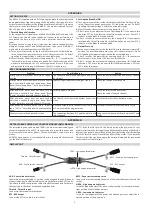
SOLOY TURBINE PAC
SECTION 3
POHS CESSNA U/TU206G
EMERGENCY PROCEDURES
3-16
F.A.A. Approved
October 4, 2005
Before descending into the clouds, set up a stabilized let-down
condition as follows:
1. Reduce power to set up a 500 to 800 ft./min. rate of descent.
2. Adjust the elevator and rudder trim control wheels for a
stabilized descent at 95 KIAS.
3. Keep hands off control wheel.
4. Monitor turn coordinator and make corrections by rudder alone.
5. Adjust rudder trim to relieve unbalanced rudder force, if present.
6. Check trend of compass card movement and make cautious
corrections with rudder to stop turn.
7. Upon breaking out of clouds, resume normal cruising flight.
RECOVERY FROM A SPIRAL DIVE
If a spiral is encountered, proceed as follows:
1. Power control flight idle.
2. Stop the turn by using coordinated aileron and rudder control to
align the symbolic airplane in the turn coordinator with the
horizon reference line.
3. Cautiously apply control wheel back pressure to slowly reduce
the indicated airspeed to 95 KIAS.
4. Adjust the elevator trim control to maintain a 95 KIAS glide.
5. Keep hands off the control wheel, using rudder control to hold a
straight heading. Use rudder trim to relieve unbalanced rudder
force, if present.
6. Upon breaking out of clouds, resume normal cruising flight.
FLIGHT INTO ICING CONDITIONS
Flight into icing conditions is prohibited. An inadvertent encounter with
these conditions can best be handled using the checklist procedures. The
best procedure, of course, is to turn back or change altitude to escape
icing conditions.
ENGINE ALTERNATE AIR SYSTEM FAILURE
Malfunction of the engine alternate air system falls into the following
categories: Alternate air light does not illuminate when in the alternate air
mode and Alternate air light illuminates when in the normal air mode. The
following paragraphs describe the recommended remedy for each
situation.
UNCONTROLLED
COPY












































